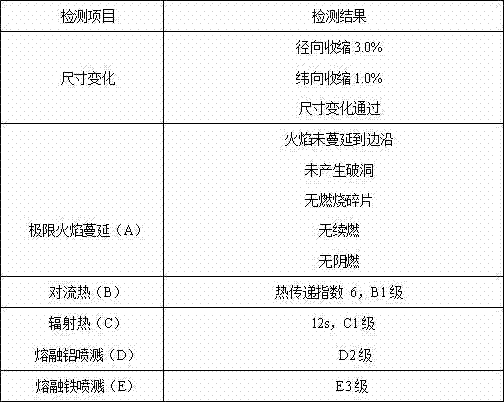Flame-retardant protective clothing fabric
A technology for protective clothing and fabrics, applied in the field of textile fabrics, can solve the problems of insufficient protection function and comfort, harmful to human body, and high temperature resistance of aluminum.
- Summary
- Abstract
- Description
- Claims
- Application Information
AI Technical Summary
Problems solved by technology
Method used
Image
Examples
Embodiment 1
[0017] Raw materials: wool fiber is 80s short wool strips, the average length is 45mm, the flame-retardant viscose fiber is Lenzing FR, the linear density is 1.7dtex, the length is 40mm, and the polyphenylene sulfide fiber is 70D filament.
[0018] 1. Manufacture of flame-retardant yarn
[0019] The flame retardant yarn is composed of fibers in the following weight percentages: 50% wool fiber, 30% polyphenylene sulfide fiber and 20% flame retardant viscose fiber.
[0020] (1) Manufacture of roving:
[0021] After the flame-retardant viscose fiber is opened and cleaned, carded and drawn with wool fiber, the roving process is formed into a roving.
[0022] The machines used in the cotton opening and cleaning process are: A002D type plucking machine, A006C type cotton mixing machine, A036C type cotton opener, A092A type cotton box feeder and A076E type single beater lapping machine.
[0023] The process parameters are as follows:
[0024] Flame-retardant viscose cotton rolls...
Embodiment 2
[0074] Raw materials: wool fiber is 80s short wool strips, the average length is 45mm, the flame-retardant viscose fiber is Lenzing FR, the linear density is 1.7dtex, the length is 40mm, and the polyphenylene sulfide fiber is 35D filament.
[0075] Except following process, other is identical with example 1.
[0076] 1. Manufacture of flame-retardant yarn
[0077] The flame retardant yarn includes the following fibers accounting for the total mass of the yarn: 55% wool fiber, 15% polyphenylene sulfide fiber and 30% flame retardant viscose fiber.
[0078] In the carding process, the raw sliver weight of the flame-retardant viscose fiber is 18.20g / 5m.
[0079] The process parameters of the drawing process are:
[0080] First-pass drawing: the wool sliver is pretreated on the first-pass drawing frame into raw sliver, with a standard weight of 20.28 g / 5m. Then feed 3 viscose strips and 5 wool strips.
[0081] Front area roller gauge: 20mm
[0082] Back area roller gauge: ...
Embodiment 3
[0110] Raw materials: wool fiber is 80s short wool strips, the average length is 45mm, the flame-retardant viscose fiber is Lenzing FR, the linear density is 1.7dtex, the length is 40mm, and the polyphenylene sulfide fiber is 70D filament.
[0111] Except following process, other is identical with example 1.
[0112] 1. Manufacture of flame-retardant yarn
[0113] The flame retardant yarn includes the following fibers accounting for the total mass of the yarn: 60% wool fiber, 25% polyphenylene sulfide fiber and 15% flame retardant viscose fiber.
[0114] In the carding process, the raw sliver weight of flame-retardant viscose is 15.60g / 5m.
[0115] The process parameters of the drawing process are:
[0116] First-pass drawing: firstly, the wool sliver is pretreated on the first-pass drawing frame into raw sliver, with a standard weight of 20.80 g / 5m. Then feed in 2 flame-retardant viscose strips and 6 wool strips.
[0117] Front area roller gauge: 20mm
[0118] Back a...
PUM
| Property | Measurement | Unit |
|---|---|---|
| length | aaaaa | aaaaa |
| twist factor | aaaaa | aaaaa |
| twist factor | aaaaa | aaaaa |
Abstract
Description
Claims
Application Information
 Login to View More
Login to View More - R&D
- Intellectual Property
- Life Sciences
- Materials
- Tech Scout
- Unparalleled Data Quality
- Higher Quality Content
- 60% Fewer Hallucinations
Browse by: Latest US Patents, China's latest patents, Technical Efficacy Thesaurus, Application Domain, Technology Topic, Popular Technical Reports.
© 2025 PatSnap. All rights reserved.Legal|Privacy policy|Modern Slavery Act Transparency Statement|Sitemap|About US| Contact US: help@patsnap.com

